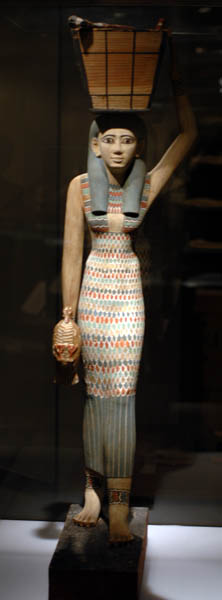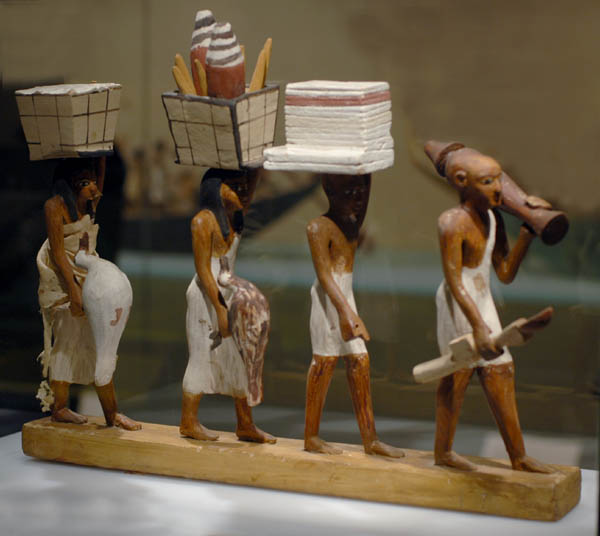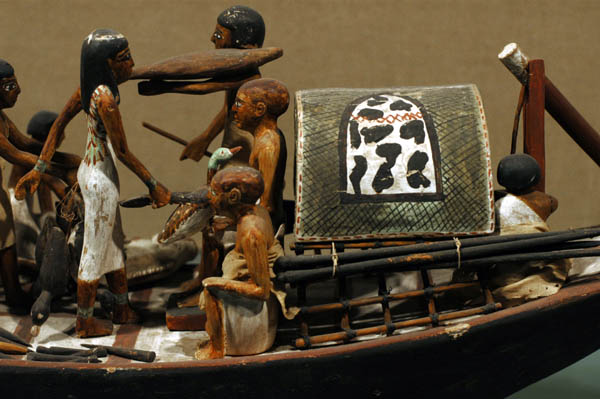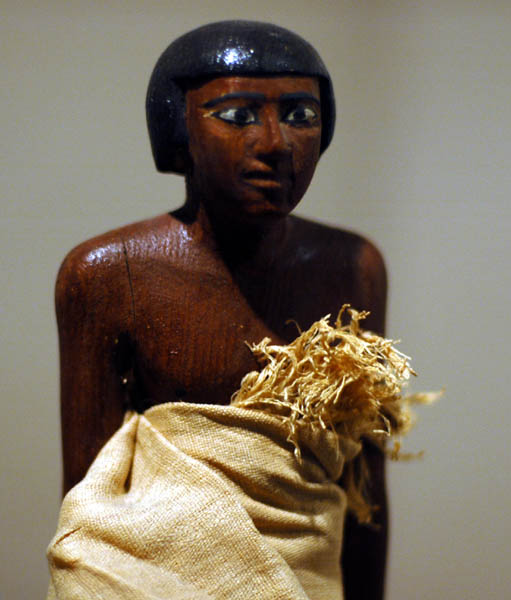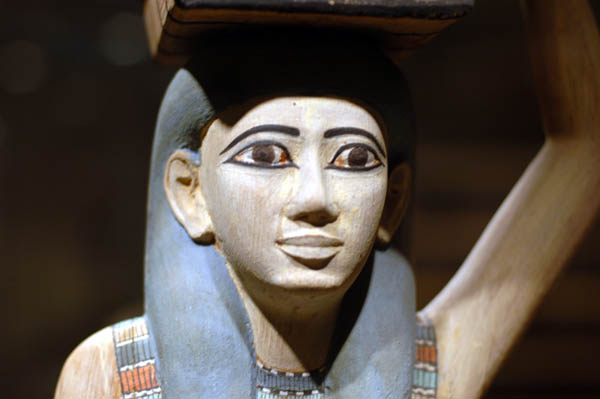
Tomb of Meketre, western Thebes
Wooden statue of a servant carrying a fowl and balancing a basket on her head. She is finely carved and painted and is one of the finest examples of this type.
This tall, slender woman was discovered in a hidden chamber in the tomb of Meketre. Looking at this graceful figure, you can see the difference between a work made in wood and one of stone. Similar conventions guide the artist, but the more flexible and forgiving medium of wood allows the sculptor to free the entire body, including the limbs, and to create what is truly a piece of sculpture in the round.
Probably, the two most prominent types of models are offering bearers and boats. Offering bearers are some of the tallest figures, as well as dating from some of Egypt's earliest periods. They tend to be female, though male offering bearers are also encountered. The females usually carry food items, while the male variety tend to carry religious items. Early offering bearers are simple pottery figures, but later, they were often made with considerable artistic skill, rivalling the statues of the tomb owner himself. This is probably indicative of the importance that the Egyptians placed on this particular variety of models, believing their afterlife was dependent on these symbolic workers.
The figure holds a live duck by its wings in one hand and balances a basket of foodstuffs on her head with the other. In rural areas Egyptians still carry heavy loads on their heads, as do people in many parts of the world.
This figure is larger than the others because she embodies the products of an entire estate that Meketre determined to be the source that would provide offerings for his funeral cult in perpetuity. Her size, broad collar necklace, bracelets, anklets, and dress indicate her importance. The patterns on her dress represent small feathers, and the vertical stripes of the underskirt, long wing feathers. Goddesses are frequently portrayed in similar costumes. Here the dress probably refers to Isis or Nephthys, both of whom protected the dead in the afterlife. Interestingly, because the action of offering is important, offering women may stride - a pose usually reserved for men. The companion figure in Cairo is dressed in a garment made of bead netting.
Since this statue is made of wood, it must have been carved from the roughly cylindrical shape of a tree trunk, yet the squared base and the frontal, balanced pose conform to the rectilinear style of stone sculpture. Unlike the case in stone sculpture, however, in wooden figures the space between body and limbs is open, creating a more lifelike appearance. The colours and patterns, as well as the figure's large eyes and slender, subtly naturalistic form, are arresting. The gray-green colour, especially on the wig but also on the garment, originally may have been blue, the hair colour of deities. The arms, base, duck figure, and basket were made separately, then attached to the body.
 Tomb of Meketre (translates to The Sun is my protection), western Thebes. He was a high official during the reign of Mentuhotep II, Mentuhotep III, Mentuhotep IV and Amenemhat I which spanned the 11th and 12th Dynasties. He served as Overseer of the Six Great Law Courts, Treasurer and Chief Steward. He died during the early years of Amenemhat's reign and was cone of the last high-officials to be buried at Thebes before the royal court moved to Lisht. Photograph by the Egyptian Expedition, The Metropolitan Museum of Art, 1920. Museum archaeologists worked at Thebes for about thirty years. They made one of their most remarkable finds inside the cut-rock tomb of a Theban official named Meketre, who was buried just after 2000 BC. The entrance to his tomb was on the terrace (in shadows in this photograph) at the top of a sloping causeway. The archaeologists knew that Meketre's tomb had been robbed in ancient times. However, while cleaning the area in order to draw an exact plan of the tomb, they discovered two places the grave robbers had missed. One was the small burial chamber of Meketre's storehouse manager Wah, whose tomb was cut into the hillside just to the right of the top of Meketre's causeway. The second was a small chamber hidden in the floor of the passageway inside Meketre's tomb.
|
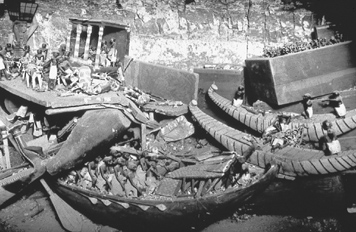 View inside the chamber of Meketre's tomb. This photograph, taken by the excavation photographer, shows what the archaeologists saw when they had dismantled a mud-brick wall that closed the entrance to the hidden chamber. Although the contents were slightly jumbled due to a partial ceiling collapse, no one had entered the chamber since it had been sealed almost four thousand years earlier. Packed tightly into the space were twenty-four painted wooden models of boats, offering bearers, and buildings containing craftsmen and preparers of food. A model of a walled garden is visible on the upper right, and in the back of the room on the left is a large wooden figure of a female offering bearer. These models are highly valued because of the quality of the carving and painting and because they are remarkably well preserved. The colours, the linen garments on some of the figures, and most of the twine rigging on the boats are original. They tell us in great detail about the raising and slaughtering of livestock, storage of grain, making of bread and beer, and design of boats in Middle Kingdom Egypt. On another level of meaning, they tell us about the Egyptian belief that images could magically provide safe passage to the afterlife and eternal sustenance once there. |


